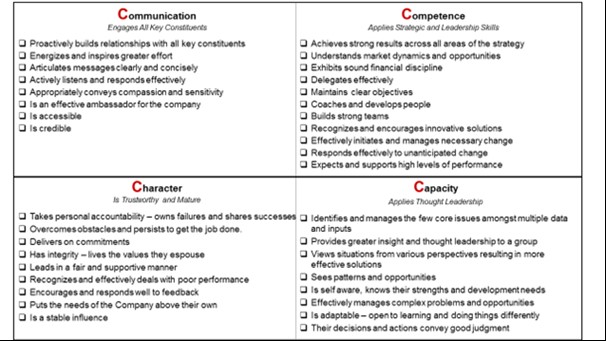Every organization has a clear need to develop future leaders – the longer-term viability of the business requires it. And, your strongest talent may leave if they aren’t being challenged, developed and don’t see a compelling career path.
So, the questions each organization should answer are:
Who can effectively lead for us in the future? and thus
Who do we make a unique development investment in?
How each organization answers these questions is at the core of their talent development strategy. And, your longer-term success is dependent up getting the answers more-right-than- wrong. The examples of companies’ fate being determined by leadership selection decisions are endless – how much different would GE have been if Jack Welch had not been identified and developed as a leader? Where would Apple be now after the passing of Steve Jobs had Tim Cook not been identified and developed in the years previous? And, how would Hewlett Packard have responded to immense market pressures if Antonio Neri had not been ready to take the reigns as CEO when Meg Whitman stepped down in 2018?
These are the more public examples at the CEO level. However, the impact of succession and development is felt at multiple levels in every company.
So, back to answering the question – who can effectively lead for us in the future?
Leader Success Profile = 4C’s
From our research and work with companies across industries, we have found four universal elements in a framework that helps differentiate those that have true potential from those that are more likely to be challenged if put into larger roles. For many talent professionals, this framework has provided a simple and useful model to apply in their daily identification and development of leaders.
The 4C Leader Profile helps leaders and professionals avoid an unusable long list of competencies while ensuring they get beyond the bias and inaccuracies that result from a less structured and subjective approach to leader assessment.
The 4C Profile is both practical and empirically sound. The 4C Profile elements include:
- Capacity – applies thought leadership
- Character – is trustworthy & mature
- Communication – engages all key constituents
- Competency – applies strategic and functional skills
The order of these elements is important. When assessing, too many times we see leaders and HR professionals focus first, and sometimes solely, on a person’s competency. This is because a person’s functional skills and experience are easiest to assess and have a clear connection to a specific role. Competency is important, however the other three C’s are critical in assessing and making accurate selection and development decisions.

Figure 1 – 4C Leadership Profile
Using the 4C Profile framework begins with assessing each candidate’s hardware. A person’s hardware is the raw material that is foundational to leadership success, and points to the kind of roles they can effectively inhabit over time. There is a strong positive relationship between a person’s Character and Capacity and the size and variety of roles, situations and environments that they can be successful in.
Hardware defined = attributes and predispositions that are largely ingrained. It is our personal “wiring” and is difficult to change.
A person’s Character goes beyond their honesty, as important as that is. Character is comprised of the persons’ attributes that have been shaped over their early life. This includes the ability to regulate behavior, maintain perspective in difficult times, persevere and apply sound judgement. This level of maturity can come with age, but is not always associated with age. Employees can exhibit this maturity early, or have the inability to manage in a seasoned and mature way their whole career.
A person’s Capacity is their ability to manage complexity and solve problems. Each of us have a limit to our capacity. Those that have the ability to navigate through complexity, think broadly and solve difficult problems can provide unique insights and a level of competitive advantage to your business.
As a company, it is important to know which employees exhibit the highest levels of character and capacity and invest in their development. Your talent acquisition activities should also be focused on sourcing and assessing candidates with great hardware.
A person’s software is much more malleable. If a person has strong capacity and character, they can develop as a communicator and influencer of people. They will also be able to develop the leadership and functional competencies required of the role and provide unique value in their roles because their wiring is strong.
Software defined = capabilities that can be developed - the area of focus to maximize performance and potential.
A person’s Communication is not simply their ability to send and receive clear messages. It is their ability to read, adjust and influence different styles, types and levels of people. The core of this is a level of empathy and self-awareness. Communication and influence is increasingly important in larger leadership roles. There are key constructs such as Emotional Intelligence (EQ) that can be used with feedback and coaching to successfully develop this area.
A person’s Competency comprises the skills and ability required of the level and in a role. This includes key functional skills (e.g. ability to manage a P/L) and strategic leadership skills (e.g. ability to form a longer-term plan for market development). Individual development should focus on the specific skills and abilities for immediate application and role success.
Assessing Using the 4C Leader Profile
In making judgements using the 4C Leader Profile, it is critical to involve multiple informed and diverse perspectives in the process. It is through the focused dialogue that keen insights are gathered and the better selection and development decisions are made.

Figure 2 – 4C Leadership Profile Indicators
These indicators are helpful, however, you may want to edit or even add a few based on the uniqueness of the Character, Capacity, Communication and Competency requirements of your business. For example, in one faith-based health care organization, they added servant’s heart and compassion to the list of Character and Communication indicators.
What unique elements does your company have?
If you find yourself getting bogged down in the detail of the indicators when discussing an employee, I encourage you to move the assessment to an a more general outcome-based litmus test – see the key question for each C in Figure 3 below.
 Figure 3 – 4C Profile Litmus Questions
Figure 3 – 4C Profile Litmus Questions
In Summary
The 4C Leadership Profile can help you and your leaders identify and develop great talent. However, be sure to make it the foundation of regular dialogue and avoid the tragic trap of coming to a final conclusion on people. You should regularly revisit your assumptions and be willing to learn more, with the focus of figuring out how you can put each person in the position to be as successful as they can be.
There are a number of additional tools that can be used to assess an employee or candidate using the 4C profile. As a firm we have helped a number of companies both structure the approach, facilitate the process, and apply validated assessment instruments for greater precision and development focus.
To learn more, visit us at www.careermp.com or request more information.



